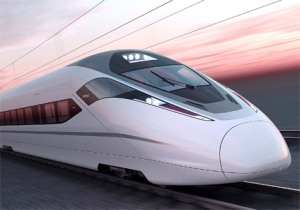 Planes haven’t yet replaced trains, at least not in the East. Less than two years after China’s first high-speed train from Beijing to Tianjin rolled out of the platform, top officials in Beijing are busy drafting a global rail network of high-speed trains that will connect China with 17 neighboring nations including India by 2012 at a cost of US$500 billion. The railway holds strategic importance for India, which shares one of the world’s longest disputed borders with China.
Planes haven’t yet replaced trains, at least not in the East. Less than two years after China’s first high-speed train from Beijing to Tianjin rolled out of the platform, top officials in Beijing are busy drafting a global rail network of high-speed trains that will connect China with 17 neighboring nations including India by 2012 at a cost of US$500 billion. The railway holds strategic importance for India, which shares one of the world’s longest disputed borders with China.
China says the plan is part of a larger pan-Asia rail network proposed in 2006 that is expected to connect 28 countries with 81,000 kilometers of railways. As part of international infrastructure developments Beijing has already begun construction of railway lines in neighboring Nepal, Cambodia, Myanmar and Vietnam.The rail link might also expand to Europe by 2025, possibly connecting London to Beijing in two days.
The proposed high-speed trains will mostly transport cargo, boosting trade throughout the region. According to China’s railway ministry, the country’s total railway coverage will be exceed 110,000 kilometers by 2012, with 13,000 kilometers of high-speed railway, forming the world’s largest high-speed railway network.
While negotiations with most countries are being finalized, Beijing said that the domestic part of the rail link is almost complete. China has envisioned three high-speed rail links spanning out from the mainland. The first line will start from Kunming in the southern province of Yunnan and run south as far as Singapore, and east as far as Tehran through New Delhi and Lahore. The second line will start in Urumqi, the capital of the Xinjiang Uyghur Autonomous Region in East China and connect neighboring Central Asian countries such as Kazakhstan, Uzbekistan and Turkmenistan with Germany. The third line will connect the city of Heilongjiang in northern China with Eastern and Southern European countries via Russia.
“India is a relatively small country with a huge population,” he told The Hindu in an interview. “It will be too costly to build highways for India, so our high-speed rail link project will improve transportation efficiency and resources. I am confident we can finally reach an agreement, which will greatly help exports to the Indian Ocean direction.” He said talks with Indian officials were “friendly,” and they had been “welcoming” of the idea
Besides improving trade links between its neighbors, China is also hoping the trains will curb air pollution from additional aircrafts and help access remote natural resources such as coal, oil and gas from Myanmar, Iran and Russia.
China began purchasing high-speed rail technology in 2004 from France, Japan, Canada and Germany. Six years on, like most technology, China’s developed its own brand of high-speed trains that run at 350 Kilometers per hour. Besides the Beijing-Tianjin high speed railway, there’s the Wuhan-Guangzhou (connecting the South-Manufacturing center) and Shanghai-Beijing ( connecting the financial capital to the political powerhouse) railway.
China’s ambitious plans come at a time when India’s proposed six high-speed train corridors remain a pipe dream. A legacy left behind by the British Raj, India’s railways have always been a source of pride for the nation, so much so that it warrants a separate budget speech in the Indian parliament , a few days prior to the financial budget. Until the 1980’s, India’s railways were ahead of China in both total length and length of electrified routes, however over the past few years, China’s rail network has outstripped India’s. In the 1950’s, the length of India’s railways was 53,596 kilometers, it now stands at 64,015 kilometers, just 10,419 kilometers, an annual average of only 180 kilometers have been added in the last 58 years, an Indian railway ministry document states.
